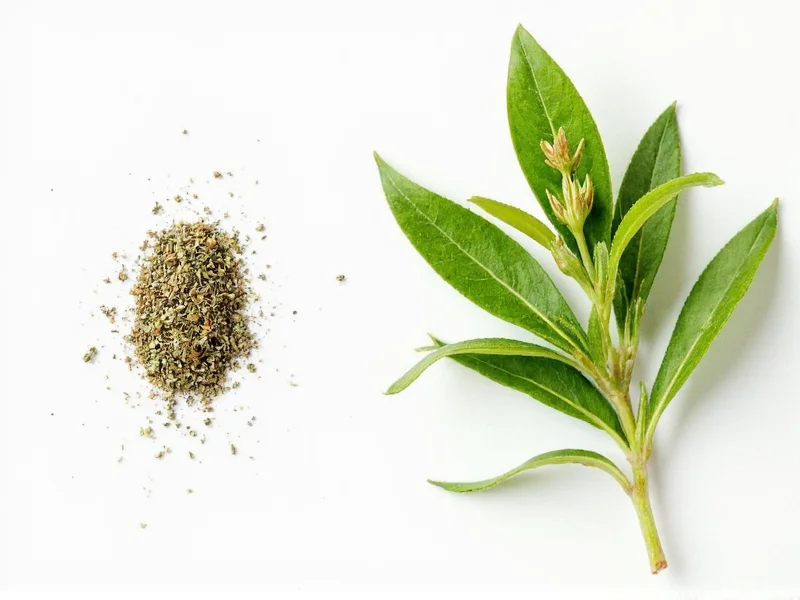When converting between fresh and dried thyme in your recipes, understanding the proper measurement ratio is essential for achieving balanced flavors. The standard culinary guideline states that dried herbs are generally three times more potent than their fresh counterparts due to the removal of water content during the drying process. This concentration means you need less dried thyme to achieve similar flavor intensity as fresh.
Why the 3:1 Conversion Ratio Matters
Thyme, like most herbs, undergoes significant chemical changes when dried. The dehydration process concentrates the essential oils and flavor compounds, making dried thyme more potent by volume. When fresh thyme loses its moisture (typically 80-90% water content), the remaining plant material becomes more concentrated.
Professional chefs and food scientists confirm that the 3:1 ratio (fresh to dried) provides the most reliable flavor balance for thyme specifically. This isn't just a kitchen myth—it's based on the actual concentration of thymol and other flavor compounds that intensify during drying.
| Dried Thyme | Fresh Thyme Equivalent | Practical Measurement |
|---|---|---|
| ¼ teaspoon | ¾ teaspoon | Just under 1 measuring teaspoon |
| ½ teaspoon | 1½ teaspoons | ½ measuring tablespoon |
| 1 teaspoon | 3 teaspoons | 1 measuring tablespoon |
| 1 tablespoon | 3 tablespoons | ¼ measuring cup |
Proper Measurement Techniques for Accurate Results
How you measure your herbs significantly impacts the final flavor of your dish. For fresh thyme:
- Strip leaves from stems before measuring (don't measure with stems)
- Gently pack fresh thyme into your measuring spoon
- Avoid compressing too firmly, which can release too much oil
- For best results, chop fresh thyme just before adding to your recipe
Dried thyme requires different handling:
- Fluff dried thyme before measuring to prevent compaction
- Use the "scoop and level" method (don't pack)
- Store dried thyme in airtight containers away from light and heat
- Check freshness—dried thyme loses potency after 6-12 months
Factors That Affect Thyme Potency
Not all thyme is created equal. Several variables influence how much fresh thyme equals 1 teaspoon dried in your specific situation:
Thyme Variety Differences
Common garden thyme (Thymus vulgaris) follows the standard 3:1 ratio, but specialty varieties like lemon thyme or caraway thyme may have different potency levels. English thyme tends to be more robust than French varieties.
Freshness Matters
Freshly harvested thyme from your garden will have stronger flavor than store-bought thyme that's been sitting for days. Similarly, dried thyme loses potency over time—older dried thyme may require slightly more to achieve the same flavor impact.
Cooking Method Impact
The timing of when you add thyme to your dish affects flavor development. Dried thyme benefits from longer cooking times to rehydrate and release flavors, while fresh thyme is often added toward the end of cooking to preserve its delicate flavor profile. When substituting fresh for dried in slow-cooked dishes, you might use slightly less than the standard ratio.
Common Substitution Mistakes to Avoid
Many home cooks make these errors when converting between fresh and dried thyme:
- Measuring with stems included: Thyme stems are woody and don't contribute flavor—always remove them before measuring fresh thyme
- Using volume measurements for dried herbs that have clumped: Break up clumps before measuring dried thyme for accuracy
- Not adjusting for recipe type: Delicate dishes like sauces may need slightly less thyme than robust stews
- Ignoring freshness: Old dried thyme has lost potency—you may need to increase the amount slightly
When to Adjust the Standard Ratio
While the 3:1 ratio works for most applications, certain situations call for adjustments:
- For delicate dishes: Use 2½:1 ratio (2½ teaspoons fresh per 1 teaspoon dried) to prevent overpowering subtle flavors
- For long-cooked dishes: Use 2:1 ratio as extended cooking time intensifies fresh herb flavors
- With very fresh garden thyme: You might need only 2½ teaspoons fresh per 1 teaspoon dried
- With older dried thyme: You may need up to 1¼ teaspoons dried to equal 1 tablespoon fresh
Always remember that personal taste preferences play a role. Start with the standard ratio, then adjust to your liking in future preparations. The best approach is to add gradually and taste as you cook—this applies whether you're using fresh thyme conversion for dried thyme measurements or making the reverse substitution.
Practical Application in Your Kitchen
Understanding fresh thyme to dried thyme conversion transforms your cooking experience. When your recipe calls for dried thyme but you have fresh from your garden or the farmers market, you can confidently make the substitution without compromising your dish.
For immediate use, remember this simple rule: triple the amount when going from dried to fresh, or use one-third the amount when substituting dried for fresh. This fresh herb conversion principle applies to most woody herbs like rosemary, oregano, and sage, though thyme follows this ratio particularly well due to its concentrated flavor profile.
Mastering this thyme measurement conversion ensures your recipes maintain their intended flavor balance whether you're working with garden-fresh thyme or pantry-stable dried varieties. The next time you wonder how much fresh thyme equals 1 teaspoon dried, you'll have the knowledge to make the perfect substitution every time.











 浙公网安备
33010002000092号
浙公网安备
33010002000092号 浙B2-20120091-4
浙B2-20120091-4